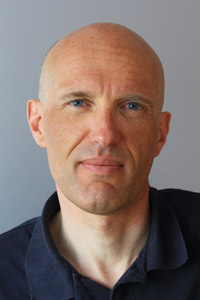Article
Through a collaboration that began more than a decade ago, Chris Chipot has remained closely linked to the work and research of the Theoretical and Computational Biophysics Group (TCBG) at the Beckman Institute. Klaus Schulten, the head of TCBG, and Chipot started working together on algorithms to investigate the thermodynamics of complex biological systems, which were ported in one of the most widely used molecular dynamics programs in the world, NAMD.
NAMD is used by researchers and scientists for a variety of simulations, including the molecular mechanisms of influenza drug resistance and the structural elucidation of the rabbit hemorrhagic disease virus. Schulten’s group distributes this program to scientists free of charge.
“This was a very fruitful endeavor, and one that set a long-standing collaboration in motion,” Chipot said. “Over the years, we’ve used the algorithms built in NAMD to tackle many research efforts.”

“They’re not rare events from the point of view of humans, but rare from a computational standpoint because they span timescales still inaccessible to routine computer simulations,” Chipot said. “It takes specialized algorithms to be able to conquer the computational complexity of some of these events, like the modeling of proteins transporting material across membranes.”
Schulten and Chipot have also recently developed another collaboration: an Associate International Laboratory (LIA), a group financially supported by both CNRS and Illinois to bring various researchers from around the world together to investigate problems in computational biophysics. One of the main components, Chipot said, is to capitalize on the synergistic expertise of dedicated scientists from many horizons.
They are working with a group of mathematicians from the École des Ponts ParisTech, outside Paris, to build on the algorithmic needs of rare-event simulations. They also collaborate with biologists, theoretical chemists, and physicists.
“We already have extremely talented scientists and developers who co-exist and produce incredible results in Klaus’ lab,” said Chipot. “Bringing other experts will hopefully inspire even bigger and more robust simulation advances.”
Among other topics, the group will focus on understanding and simulating photosynthesis and chemotaxis more precisely. Both processes are highly complex, and as of yet, not fully understood at the atomic level.
Chemotaxis refers to the motion of biological objects in response to a chemical stimulus. Schulten’s group investigates chemotactic behavior in bacteria, which can be viewed as paradigms for more complex processes such as cancer metastasis and immune responses. Mapping out the process will hopefully illuminate why these phenomena occur.
“How these signals, both mechanical and chemical, are converted into movement remains largely unknown at the atomic level,” Chipot said. “Klaus’ group has endeavored to examine how the different units of the signal receptor self-assemble and operate. The specific tools developed in my group will help to address the underlying biologically slow events.”
Photosynthesis is a ubiquitous process used by plants and bacteria to convert light to energy, and of special interest to this group. One of Chipot’s goals is to understand the ATP synthase, a molecular motor, which is a key component of the photosynthetic machinery, responsible for the synthesis of ATP—the energy source of many metabolic processes.
“Dissecting at the atomic level how ATP synthase works is a tremendous challenge for theory. We are working to describe, using high-performance computer simulations and specific algorithms that address rare or very slow events, the full cycle of ATP synthesis,” said Chipot.
Chipot is collaborating with Schulten’s students to help advance this research, in particular Abhi Singharoy, Beckman Postdoctoral Fellow, and Keith Cassidy, graduate student in physics, who are part of the TCBG.
“I really like the organization and structure of this group and the Beckman Institute. It’s an extremely productive environment, which keeps Klaus’ group at the bleeding-edge of its field,” Chipot said.
Chipot plans to stay at Beckman until at least the end of April and then return to France, while continuing to maintain the collaboration built through CNRS and Illinois.
Beckman Institute for Advanced Science and Technology